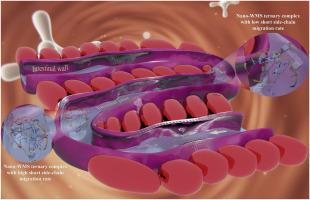揭示短侧链迁移对超声处理纳米级支链淀粉内源三元配合物消化动力学和多尺度结构的影响
IF 11
1区 农林科学
Q1 CHEMISTRY, APPLIED
引用次数: 0
摘要
支链淀粉复合物作为一种创新的膳食补充剂,在调节血糖指数的快速增加方面具有显著的潜力。然而,控制其抗消化性的机制在很大程度上仍然未知。因此,本研究考察了短侧链迁移对白蜡玉米支链淀粉(WMS)复合物抗消化率的影响。利用4-α-葡萄糖转移酶和淀粉蔗糖酶制备了具有不同短侧链迁移速率的WMS浆料,并通过超声辅助工艺制备了纳米级WMS配合物。用络合指数评价支链淀粉与蛋白质和脂质基团的自组装能力。与WMS浆料相比,纳米级WMS三元配合物由漫射型转变为v型晶型。与WMS浆料相比,这导致WMS复合物对消化酶具有显著的抗性。此外,增加纳米级WMS配合物的短侧链迁移速率,可以提高配合指数、短程有序度、分子构象指数、摩尔质量、分子密度、结晶单元平均特征尺寸、糊化温度、电势和抗性淀粉(RS-V),同时降低半晶片厚度、旋转半径、颗粒表面纳米结节(小块)尺寸、粒径、慢速和快速消化淀粉。从慢消化淀粉期到RS-V期的消化速率和预期血糖指数。基于化学计量学分析,对于短侧链迁移,配合物表现出更大的侧链位点对配体残基的可及性,加强非共价相互作用,加速球晶成核。这种增加的分子均匀性和密度导致抗消化率增加。总的来说,这些发现为设计基于支链淀粉的多组分抗消化食品提供了一个新的理论框架。本文章由计算机程序翻译,如有差异,请以英文原文为准。

Revealing the impact of short side-chain migration on the digestive kinetics and multiscale structure of ultrasound-treated nano-scale amylopectin endogenous ternary complexes
Amylopectin complexes, as innovative dietary supplements, have significant potential in modulating rapid increases in the glycemic index. However, the mechanisms governing its anti-digestibility remain largely unknown. Therefore, this study investigated the effects of short side-chain migration on the anti-digestibility of white waxy maize amylopectin (WMS) complexes. WMS paste exhibiting different short side-chain migration rates were obtained using 4-α-glucotransferase and amylosucrase, and used to prepare nano-scale WMS complexes through an ultrasound-assisted process. Self-assembly capacity of amylopectin chains with protein and lipid groups was evaluated using a complexing index. Compared to the WMS paste, the nano-scale WMS ternary complexes transitioned from a diffuse pattern to a V-type crystalline type. This caused significant resistance of the WMS complexes to digestive enzymes compared to that of the WMS paste. Furthermore, increasing short side-chain migration rates of nano-scale WMS complexes increased the complexing index, short-range order, molecular conformation index, molar mass, molecular density, average characteristic size of crystallite unit, gelatinization temperature, potential, and resistant starch (RS-V), while reducing semicrystalline lamellae thickness, radius of gyration, size of particle surface nano nodule (blocklet), particle size, slowly and rapidly digestible starch, digestive speed rate from slowly digestible starch phase to RS-V phase, and expected glycemic index. Based on chemometric analyses, for short side-chain migration, the complexes showed greater accessibility of side chain sites to ligand residues, strengthened noncovalent interactions, and accelerated spherulite nucleation. This increased molecular homogeneity and density led to increased anti-digestibility. Collectively, these findings provide a novel theoretical framework for designing amylopectin-based multicomponent anti-digestible foods.
求助全文
通过发布文献求助,成功后即可免费获取论文全文。
去求助
来源期刊

Food Hydrocolloids
工程技术-食品科技
CiteScore
19.90
自引率
14.00%
发文量
871
审稿时长
37 days
期刊介绍:
Food Hydrocolloids publishes original and innovative research focused on the characterization, functional properties, and applications of hydrocolloid materials used in food products. These hydrocolloids, defined as polysaccharides and proteins of commercial importance, are added to control aspects such as texture, stability, rheology, and sensory properties. The research's primary emphasis should be on the hydrocolloids themselves, with thorough descriptions of their source, nature, and physicochemical characteristics. Manuscripts are expected to clearly outline specific aims and objectives, include a fundamental discussion of research findings at the molecular level, and address the significance of the results. Studies on hydrocolloids in complex formulations should concentrate on their overall properties and mechanisms of action, while simple formulation development studies may not be considered for publication.
The main areas of interest are:
-Chemical and physicochemical characterisation
Thermal properties including glass transitions and conformational changes-
Rheological properties including viscosity, viscoelastic properties and gelation behaviour-
The influence on organoleptic properties-
Interfacial properties including stabilisation of dispersions, emulsions and foams-
Film forming properties with application to edible films and active packaging-
Encapsulation and controlled release of active compounds-
The influence on health including their role as dietary fibre-
Manipulation of hydrocolloid structure and functionality through chemical, biochemical and physical processes-
New hydrocolloids and hydrocolloid sources of commercial potential.
The Journal also publishes Review articles that provide an overview of the latest developments in topics of specific interest to researchers in this field of activity.
 求助内容:
求助内容: 应助结果提醒方式:
应助结果提醒方式:


